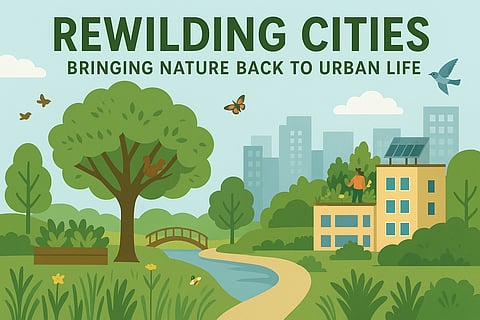Rewilding Cities: Bringing Nature Back to Urban Life
Cities, once built as fortresses against the unpredictability of nature, are now rediscovering the value of living with it. As urban populations swell and concrete landscapes sprawl, the call to rewild cities—restoring ecosystems within urban environments—has become more urgent.
Rewilding doesn’t mean turning cities into jungles but designing them to work in harmony with natural systems, enhancing both ecological resilience and human well-being.
The Promise of Urban Forests
Urban forests are not just collections of trees; they are living infrastructures. A well-planned canopy reduces the urban heat island effect, filters polluted air, and provides habitats for birds and pollinators.
In cities like Singapore and Melbourne, urban forests are integrated into transport corridors, parks, and residential areas, turning grey streets into shaded green avenues. For residents, the benefits are immediate—cooler neighborhoods, better mental health, and more opportunities to connect with nature daily.
Rooftop Gardens: Greening the Vertical City
With limited land at ground level, rooftops are becoming fertile grounds for greenery. From vegetable gardens in New York to solar-integrated green roofs in Berlin, these spaces capture rainwater, reduce building heat loads, and promote food resilience.
They also provide micro-habitats for bees, butterflies, and small birds, allowing biodiversity to thrive even in dense city cores. For citizens, rooftop gardens add both beauty and utility—fresh produce, cooler homes, and calming retreats high above the noise.
Biodiversity Corridors: Linking Fragmented Habitats
One of the biggest challenges for wildlife in cities is fragmentation. Roads, railways, and buildings create isolated patches of green that species struggle to navigate. Biodiversity corridors—green bridges, riverbanks, and connected park systems—are solutions that reconnect these fragmented ecosystems.
For example, wildlife crossings in Europe and Asia allow animals to move safely, while urban river restorations have revived fish populations and improved water quality. Corridors not only benefit wildlife but also enhance urban recreation, cycling routes, and pedestrian-friendly spaces.
Cities Co-Existing with Nature
Rewilding cities is more than planting trees—it’s rethinking how infrastructure, buildings, and people interact with the environment. Permeable pavements mimic natural ground absorption, wetlands treat stormwater, and native plant landscapes reduce maintenance while supporting local species.
A rewilded city balances human needs with ecological ones, ensuring clean water, cleaner air, and resilient food systems.
At its heart, rewilding is about reconnection: people reconnecting with nature and cities reconnecting with their ecological roots. As the pressures of climate change and urban growth intensify, rewilded cities show us a way forward—not as concrete jungles, but as living ecosystems where humans and nature can thrive side by side.


